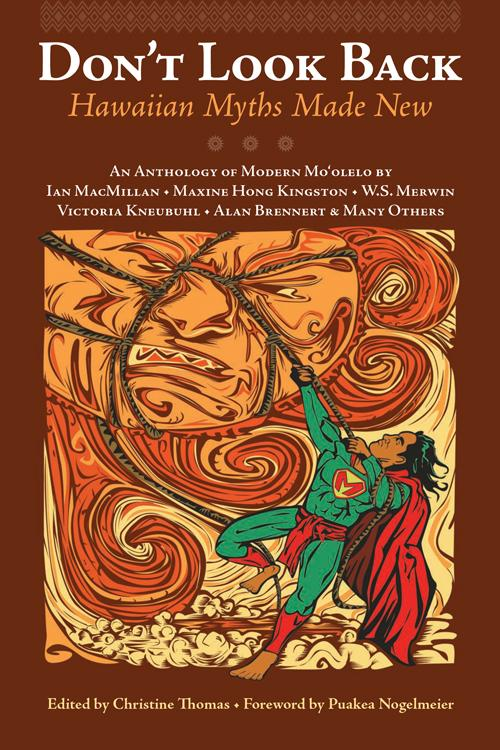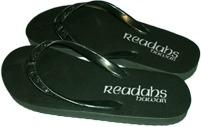 Don’t Look Back: Hawaiian Myths Made New (Watermark Publishing, 2011) is a compilation of short stories and excerpts from local authors inspired by Hawaiian legends. Edited by Christine Thomas with a Foreword by Puakea Nogelmeier, Don’t Look Back is a must-have addition to any myth lover’s library.
Don’t Look Back: Hawaiian Myths Made New (Watermark Publishing, 2011) is a compilation of short stories and excerpts from local authors inspired by Hawaiian legends. Edited by Christine Thomas with a Foreword by Puakea Nogelmeier, Don’t Look Back is a must-have addition to any myth lover’s library.
Myths and legends are a common denominator meant to convey ideas, instill mutual values and teach us lessons. They have the power to both shape and reflect our community and the writers that contributed to this book have taken those ethereal stories of Hawaiian myth and brought them new or revived relevance. Here are a few reasons why you should read this book:
A.A. Attanasio’s story about Kapoʻulakinaʻu, one of the akua, the gods, in her current form as an astrophysicist on Mauna Kea, is a perfect marriage of sci-fi and myth. Kapoʻulakinaʻu jokes about her sister Pele, who is currently in dog form spending the days running about the UH Observatory. I particularly loved how he attributed the October 15th, 2006 earthquakes that shook the Big Island to Pele being sick on contaminated dog food from China. The way a professional designer can take the basic elements of a room and create something original and magnificent is the same way that Attanasio creates a story. There are too few wordsmiths of his calibre.
“I” is a bird that tugs the reins of the wind. “I” is a fish without a thought in her head. “I” is a butterfly heavy in the air. “I” is a boulder feeling for some inner truth. “I” is an astrophysicist with a shoehorn smile. “I” is mythology.
—Sex, Love and the Mighty Fine Structure Consonant, A.A. Attanasio
Darien Gee’s story about Pele in therapy is exactly what you’d want out of a book like this. If there’s any character from Hawaiian legend who should be in therapy, it’s Pele… and before I am mercilessly struck down, I say that with utmost respect. What I like so much about Darien (aka Mia King) is how elegantly, yet truthfully, she portrays people going through life altering situations. She writes emotion well, and not the whining “woe is me” variety, but the simple and honest kind that leaves room for the reader to hope. As with any appropriate Pele tale, this one too is about transformation. Gee’s interpretation of Pele is pure aces.
I loved how Wayne Moniz took the legend of the White Lady of ʻĪao Valley and gave it a backstory—the way he took a short urban legend and elevated it to the realm of myth. His story of who he thinks the White Lady is and how she came to be is so flawlessly written I feel like it was a Hawaiian legend I’ve known all along. Tales of love and loss are typical of island lore and Moniz uses those themes to construct an all too believable history around this popular local ghost. It’s a good example of how people continuously use mythology to create new stories.
Speaking of tales of love and loss, Victoria Nalani Kneubuhl writes in poetic detail about what really happens in the legend of Hiku and Kawelu, similar to the myth of Orpheus going to Hades for Eurydice. That’s the thing about myths, their ethereal quality often comes with an annoying lack of specifics. Kneubuhl takes the bare bones legend and fleshes it out in a rendition that feels both modern and ancient. She has a knack for doing that, I think.
J. Freen’s story inspired by the Lō Ai Kanaka, or Tahitian cannibals who migrated to Hawaiʻi, is sure to give me nightmares. The “delicious” and eerie way he writes about a secret organization that sways powerful people and politicians into changing land development regulations by getting them addicted to man-meat, is really chicken-skin stuff. He masterfully weaves an old legend into a modern cautionary tale that’s rife with metaphor and not a little conspiracy.
Don’t Look Back is packed with a super-star list of great local writers, each with unique and interesting story ideas. Christine Thomas’ haunting tale of siblings, that ended up being similar to the Legend of Halemano, was the inspiration for this collection and is appropriately included. Gary Pak writes about a man and house full of moʻo and now I’ll never look at geckos the same way again. Even Maxine Hong Kingston chimes in with an excerpt from one of her columns out of the New York Times. It’s always fun to read Arthur Rath, he seems to have extraordinary insight into menehune and I don’t think a compilation of contemporary work inspired by Hawaiian legends would be complete without him. And finally, Kuʻualoha Hoʻomanawanui’s story inspired by Hina, Goddess of the Moon is about a woman in an abusive relationship. It’s a great example of how myths, whether they’ve been made new or not, still have something to teach us.
There’s so much to say about this book that I fear I could go on and on. However, there were a few stories where I struggled to find the myth that inspired it. I just didn’t see the connections. The excerpts from other works were nice although I’m spoiled and always want something different from authors in an anthology—something original and specific just to that. Overall, I greatly enjoyed reading everyone’s work. In fact, I didn’t want it to end. I’m curious to see how other people would redo, undo, combine, interpret, deconstruct or pay tribute to Hawaiian legends.
When I think of modernized myths, I not only think of the old stories set in current (or future) times but I also think of what these characters would be like and how they would adjust. I wonder, are myths really as timeless as they seem? And then I think, yes. Yes they are, with generations of new myth makers and books like these.
Don’t Look Back: Hawaiian Myths Made New
(Watermark Publishing, 2011)
ISBN 978-1-9356901-4-6
Softcover, $17.95
Book Launch Event
The official book launch for Don’t Look Back will be as follows:
Wednesday, December 14, 2011 from 6:00pm – 7:30pm
Mission Houses Museum (553 S. King Street)
Light refreshments. Free street parking after 6:00pm.
Reading will begin at 6:30pm
Free and Open to the Public.
An RSVP is requested for attending. You can do so on the book launch’s official Facebook event page.




